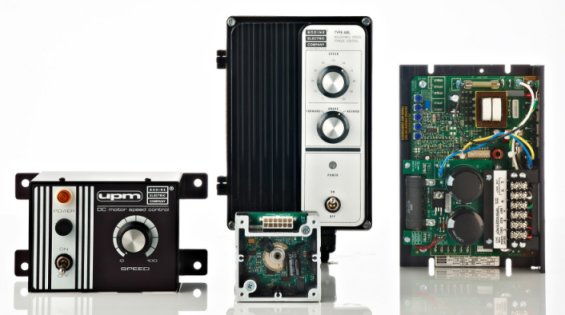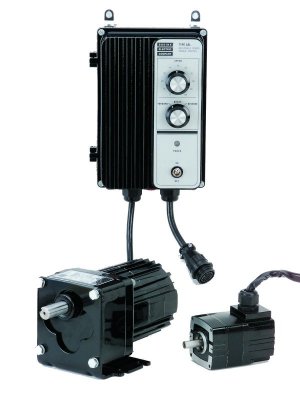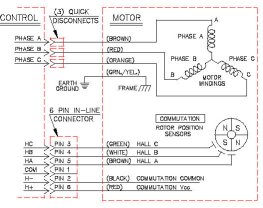One of our authorized distributors called our Tech Support staff in Chicago recently because his customer was having problems with a Bodine 34B4BEBL brushless DC motor and our ABL-3911 control. Our products were designed into a new machine that is used to induction-harden steel shafts.
1) Because of the distance between the motor and the control, the customer had made his own wiring harness instead of using a pre-made cable kit, like our model 3983. Because of a termination error with their home-made wire harness, they connected the signal common to earth ground and destroyed one control. Not only did they blow up an IC on the control board but they also damaged a Hall effect sensor in the motor.
2) The problem they were having was that when the control was turned on, the motor would not rotate. The motor shaft just vibrated in place. This can be the case when the motor phases are energized in the wrong sequence. We asked the distributor to make sure that the Hall effect sensor wires weren’t connected wrong. We also suggested that one way they could rule out the possibility of the homemade cable having any shorts or wrong connections in it would be to use Bodine’s Model 3983 cable kit just for testing. If the motor and control operated properly with our Model 3983, then we would know that the homemade cable was the source of the problem. However, the customer insisted that they had already checked and double-checked their wiring and that it was correct.
3) Fortunately, our distributor checked it as well, and found that two wires had indeed been crossed. After this had been corrected, a new problem showed up. Now the customer reported that when they turned the control on, the motor sped up by itself and then stopped by itself. It wouldn’t start again after that. At this point, the distributor asked our Tech Support staff member to join him at the customer’s plant.
4) We looked the system over and confirmed that it wouldn’t start. We checked the dip switches and confirmed that they were in the proper positions for the motor that was being used. We asked if either of the fuses was blown. The customer insisted that they’d checked the fuses and that they were fine. Again, the distributor checked as well and found a blown control fuse. We replaced the fuse and turned the control on. The motor sped up by itself and after a while stopped by itself just as the customer had described. The motor fuse was blown again. We now also realized that the acceleration potentiometer was turned fully clockwise (for longest acceleration time) which made it seem that the motor was speeding up by itself. In actuality, it was just taking a long time for the motor to accelerate to the set speed. We then turned our attention to the fuse that kept blowing.
5) We explained to the customer that Bodine’s ABL-3911 control, when configured for our 34B4BEBL BLDC motor, uses a 2 amp motor fuse and that, since the fuse is blowing, the motor must be drawing more than 2 amps for an extended period. Since current draw is directly proportional to the motor load for a brushless DC motor, the motor must be overloaded. We put a new fuse in and measured the current draw. The motor was drawing 4 amps. We also noted that the current increased significantly as we increased the motor speed, which led us to question the suitability of the customer’s load bearing for high speed operation. We checked the bearing and the chain between the motor and the load.
6) The chain was so tight that we could not budge it. When they loosened the chain, the current dropped down to 2 amps. The bearing they were using was not lubricated and seemed to be misaligned. When it was replaced with a lubricated bearing, the current dropped to less than 1 amp. We now had a happy customer who could demonstrate his new machine to his customer.
This is not the first application support call where the motor and control were blamed for a problem when, in fact, the problem was just a symptom of the true problem.
To identify and solve the root-cause of the problem, we did the following: (1) we checked and corrected the wire connections, (2) we confirmed that the control’s dip switches were set properly, (3) we checked and replaced blown fuses, (4) we measured the current draw of the motor under load and determined that it was overloaded, and (5) we identified ways to reduce the load.
Copyright Bodine Electric Company © 11/2010. All rights reserved

- Motion Controls for Brushless DC and PMDC (FHP) gearmotors and motors: Designed & Manufactured in Chicago (U.S.A.)
Contact us at: info@bodine-electric.com







